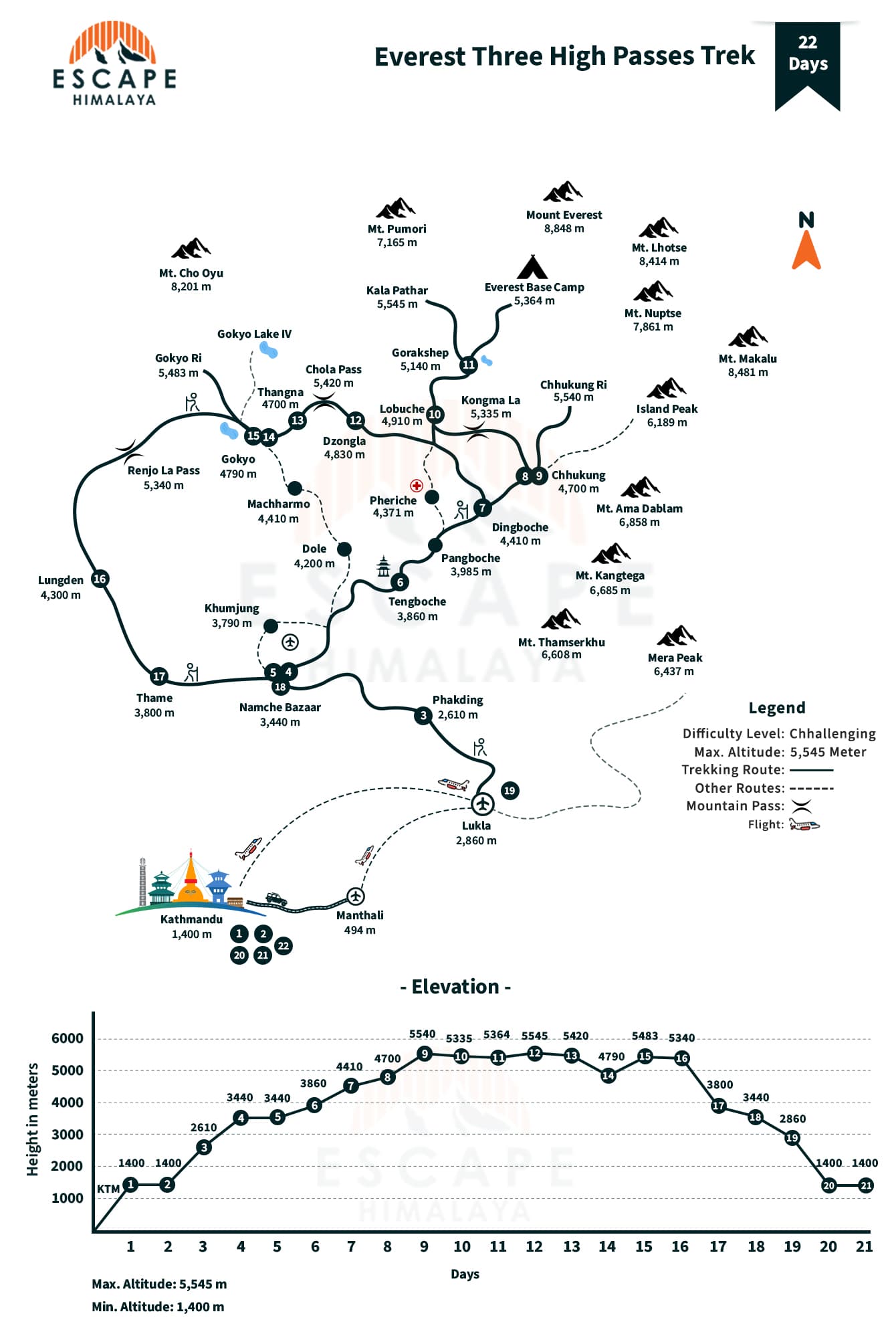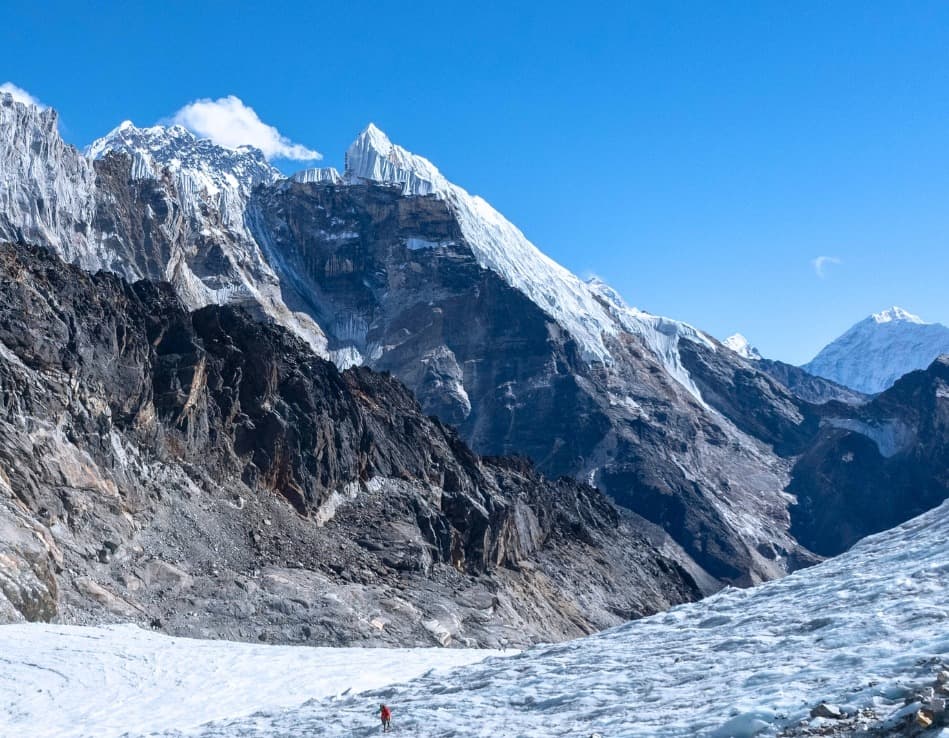Experience journeying across the captivating three high passes in the Everest region of Nepal in one setting! Everest Three High Passes Trek is an adventure that lets you comprehensively scale three high passes in Khumbu.
The three stunning high passes, Kongma La Pass, Cho La Pass, and Renjo La Pass, are spectacular viewpoints in the Everest region. Crossing them will be like traversing along a celestial terrain enveloped in snow. It is one of the most exciting journeys with the best views of mountains and cerulean glaciers. Walking across the icy landscape of the high passes presents a thrilling exhilaration that only comes with this challenge. You'll face the high elevations and the rocky terrains as two main challenges on the Everest High Passes Trek. The mountains' grand landscapes and snow-covered terrains present a challenge, unlike anything you have experienced. The journey is worth all the challenging aspects because the views from all these passes are fantastic! Further, an all-encompassing panorama of landscapes and nearby ivory peaks from the top of these passes makes it a worthwhile experience!
The Everest High Passes Trek includes Everest Base Camp with a hike to Kala Patthar, crossing three monumental high passes, and climbing up to the Gokyo Ri. It takes you along a less-traveled trail to the Everest Base Camp following Kongma La Pass. You would be exposed to giant Himalayas like Mount Everest, Lhotse, Cho Oyu, Makalu, and many more! The impressive sights of the mountains are genuinely prepossessing to look at. You will enjoy the unique taste of nature and culture throughout the trek as you go to far-off ethnic settlements. This way, you are offered an opportunity to look closely at the authentic Sherpa traditions and rituals. Moreover, the vibrant and dainty villages, monasteries, chortens, and gumbas across the journey will enhance your trekking experience.
Escape Himalaya lets you experience this ostentatious trek adventure of safely crossing three passes of Nepal. Meanwhile, interacting with the locals and traversing the high Himalayan terrains makes it mesmerizing. With azure lakes, beautiful sceneries, snowy landscapes, ethnic villages, and high passes, the Everest Three High Passes Trek is an adventure like never before. If you are looking for alternate packages for this trip, you can do the Everest Chola Pass Trek. Likewise, you can also go on a Gokyo Lake Trek with Renjo La Pass. There is much more to introduce yourself with trekking in the Himalayas. We can make it a remarkable experience if you want to have it as you have wished. So join us for an adventure of a lifetime!
Best Time For Everest Three Passes Trek
The best time for the Everest Three Passes Trek is during spring (March to May) and autumn (September to November). These seasons offer the most stable weather conditions, with clear skies, moderate temperatures, and minimal rainfall. Trekking during spring means you'll experience mild temperatures and stunning views of blooming rhododendrons in lower altitudes, while higher elevations offer crisp weather and clear visibility of the towering peaks. Autumn is equally ideal, with crisp, dry days and minimal cloud cover, providing the perfect conditions for trekking through the high passes.
During these months, you’ll also avoid the extreme cold of winter (December to February), when temperatures can drop below freezing, especially at higher altitudes, making the trek much more challenging. The summer monsoon (June to August) is generally not recommended due to heavy rain, which can make the trails slippery and increase the risk of landslides. Therefore, spring and autumn are considered the prime trekking seasons.
Physical Fitness for Three Passes
The Everest Three Passes Trek is a physically demanding journey that requires solid physical fitness. Endurance is crucial, as you'll be trekking long hours each day, often between 6 to 8 hours. Good cardiovascular fitness will help you manage the sustained effort over multiple days. Strength in your legs is essential for the steep ascents and descents, especially when crossing the high passes, like Kongma La, Cho La, and Renjo La.
Additionally, stamina to adapt to high altitudes is key. The trek takes you above 5,500 meters (18,000 feet), where oxygen levels are lower, so physical fitness aids in better acclimatization and reduces the risk of altitude sickness. Finally, mental toughness is essential for enduring the challenging terrain, weather, and the demanding nature of the trek. Training with cardio, strength exercises, and hiking on varied terrain will ensure you're physically prepared for this incredible adventure.
Why Choose Everest Three Passes Trekking
The Everest Three Passes Trek is a challenging and rewarding adventure, offering breathtaking views of Everest and surrounding peaks, including Lhotse, Makalu, and Cho Oyu. It takes you through diverse landscapes, from lush forests to rugged alpine terrain, and requires crossing three high passes Kongma La, Cho La, and Renjo La each providing a unique challenge and sense of achievement. Along the way, you'll experience the rich culture of Sherpa villages, including Namche Bazaar and Dingboche, where you can immerse yourself in local traditions and Buddhist practices. The trek is less crowded than the Everest Base Camp route, offering a more remote and peaceful experience. With stunning scenery, physical challenges, and cultural exploration, the Everest Three Passes Trek is the perfect choice for trekkers seeking an unforgettable Himalayan adventure.
Highest Views This Trip
The Everest Three Passes Trek offers some of the most spectacular mountain views in the world. Trekking through high passes like Kongma La, Cho La, and Renjo La, you'll be treated to breathtaking vistas of Mount Everest, Lhotse, Makalu, and Cho Oyu. The trek also offers stunning views of Ama Dablam, the dramatic Khumbu Icefall, and Island Peak. With its diverse landscapes, rugged terrain, and unbeatable panoramas, this trek provides an unparalleled opportunity to experience the grandeur of the Everest region, making it an unforgettable adventure for avid trekkers and mountain enthusiasts.
About Lukla Airport
Flights from Kathmandu to Lukla are the primary gateway for trekkers heading to the Everest region, offering a quick yet thrilling way to begin the adventure to Everest Base Camp. The flight typically lasts around 25-30 minutes and covers the 138-kilometer distance between Tribhuvan International Airport (KTM) in Kathmandu and Tenzing-Hillary Airport (LUA) in Lukla, one of the most exciting and challenging airports in the world, known for its steep, short runway nestled in the mountains.
Three main airlines serve this route Tara Airlines, Summit Airlines, and Sita Air. These flights generally depart in the morning, with the first flights around 6:00 AM, and typically run until 10:00 AM. However, due to the unpredictable weather conditions in the Himalayas, flights can often be delayed or canceled, particularly in winter and during the monsoon season. It’s important to allow for flexibility in your schedule and have contingency plans in case of flight disruptions.
Weight Limit For Lukla Flight
The weight limit for flights from Kathmandu to Lukla is typically 15 kilograms (33 pounds) per person for checked luggage. This limit is strictly enforced by the airlines due to the small size of the aircraft and the limited cargo capacity. Passengers are allowed to carry additional weight in the form of hand luggage, but this is usually restricted to 5 kilograms (11 pounds). If you exceed the weight limit, you may be required to pay additional fees or arrange for the excess baggage to be sent by another means, such as via a porter or a cargo flight.
Preparing for the flight to Lukla requires careful attention to weight limits, Airlines said only 15kg for each person including hand carry bag as excess luggage can pay extra charges, making it essential to pack efficiently.









